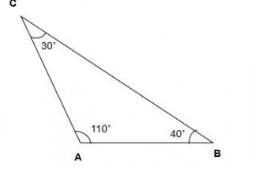A triangle is a two-dimensional plane figure with three sides and three angles that is closed in two dimensions. When the sides and interior angles of a triangle are taken into consideration, a variety of different types of triangles are formed, with the obtuse-angled triangle being one of them. When one of the interior angles of a triangle is obtuse (i.e. greater than 90°), the triangle is referred to as an obtuse-angled triangle (or obtuse-angled triangle).
There are three angles in the triangle, and the obtuse angle can be any one of them, while the remaining two angles are both acute. This triangle is referred to as an obtuse triangle in some circles. Apart from the obtuse triangle, the acute and right triangles are the other two types of triangles that are based on the angles. The acute and obtuse angles of a scalene triangle, on the other hand, are the best examples.
Obtuse angle:
Defining of an obtuse angle as one that is always less than 180 degrees and greater than 90 degrees.
It is possible to form three different types of angles by joining any two line segments end to end in a straight line. They are as follows:
- Acute angle
- Right angle
- Obtuse angle
In geometry, an acute angle is formed when two line segments are joined in such a way that the angle formed by the two segments is less than 90 degrees. The triangle formed as a result of this angle is referred to as an acute angle triangle.
In mathematics, a right angle is formed when one line segment is exactly perpendicular to another line segment at the points where the two lines meet.
Obtuse angled triangle formula:
The formula for calculating the area and perimeter of an obtuse triangle is the same as the formula for calculating the area and perimeter of any other triangle.
As a result, the area of the triangle can be calculated as follows:
Area= ½ × b × h
in which b is the base of the triangle and h is the height of its peak.
Or
A= √s(s-a)(s-b)(s-c)
sq.units
Where s = (a+b+c)/2 (s = semiperimeter)
where a, b, and c are the lengths of the triangle’s sides, respectively.
Unless otherwise stated, the perimeter of a triangle is always equal to the sum of the triangle’s sides. Therefore, when the sides of an acute triangle are denoted by the letters a, b, and c, the perimeter can be calculated as follows:
The perimeter is equal to the sum of the squares a, b, and c.
How to check the triangle is obtuse:
A triangle can be easily distinguished from an obtuse triangle if only two angles of the triangle are given; otherwise, the triangle cannot be distinguished. But, given that we already know the three sides of the triangle, how do we figure out the third? In order to test this, we have an inequality along the lines of Pythagorean identity.
If the sum of the squares of the smaller sides is less than the sum of the squares of the largest side, the triangle is said to be obtuse.
Suppose that a, b, and c are the lengths of the sides of the triangle ABC, with c being the longest side. If the triangle is obtuse, then the longest side of the triangle is shorter than the other two sides.
a2 + b2 < c2
Obtuse angled triangle properties:
- A less than 90-degree angle is formed by adding the sum of the two angles that are not obtuse.
- The longest side of a triangle is the side that is opposite the obtuse angle of the triangle.
- An obtuse triangle will have only one obtuse angle, and that angle will be the shortest of the three. The other two angles are acute angles, as the name implies.
- The points of concurrency, the Circumcenter, and the Orthocenter, are located outside of an obtuse triangle, whereas the Centroid and the Incenter are located within the triangle’s confines, respectively.
Conclusion:
One of the interior angles of an obtuse-angled triangle measures more than 90 degrees. A triangle is a two-dimensional plane figure with three sides and three angles that is closed in two dimensions.There are three angles in the triangle, and the obtuse angle can be any one of them, while the remaining two angles are both acute.Apart from the obtuse triangle, the acute and right triangles are the other two types of triangles that are based on the angles.
In geometry, an acute angle is formed when two line segments are joined in such a way that the angle formed by the two segments is less than 90 degrees.
The longest side of a triangle is the side that is opposite the obtuse angle of the triangle.
An obtuse triangle will have only one obtuse angle, and that angle will be the shortest of the three. The other two angles are acute angles, as the name implies.
 Profile
Profile Settings
Settings Refer your friends
Refer your friends Sign out
Sign out







